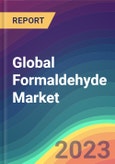Formaldehyde is an aldehyde and is a highly flammable, colorless gas with a strong pungent smell. It is mainly produced by the vapor-phase oxidation of methanal. Naturally, it is produced by almost every living organism during cellular metabolism. Formaldehyde is used extensively as a precursor in the production processes of various chemicals, like industrial resins, for manufacturing plywood, particle boards, fiberboards, adhesives and glues, permanent press fabrics, industrial coatings, and insulation materials. It also finds application in dyes, glass mirrors, cellulose esters and artificial silk, organic chemicals, explosives, industrial disinfectant, as a preservative, storage houses, utensils, clothes, etc., as a fungicide or germicide in agriculture, the tanning industry, waterproofing of fabrics, preserving & coagulating rubber latex, as embalming fluids, in the manufacture of photographic materials, antiseptics, in pulp & papers treatment, in cosmetics, fuels, mouth wash, in surgical instruments sterilization and germicidal soap, etc.
The primary driver of the global Formaldehyde market is its usage in the building & construction sector. Formaldehyde resins are heavily used in this sector because of their properties such as stiffness, scratch resistance, moisture & mold resistance, high tensile strength, low coefficient of friction, high heat-distortion temperature, and cost-effectiveness. Formaldehyde finds applications in the form of Industrial resins, such as Urea-Formaldehyde resin, Phenol-Formaldehyde resin, Melamine- Formaldehyde resin, and acetal resin. These resins are majorly used as thermosetting plastics in Building & Construction, Household & Kitchenware, and automotive domains. Among these resins, Urea-Formaldehyde is the leading segment in terms of demand. The formaldehyde Market is expected to grow at a significant rate over the forecast period owing to its vast applications and reach a volume of 36 million tonnes by 2032.
Based on region, the Asia Pacific is dominating the Formaldehyde market. In 2022, Asia Pacific held demand of approximately 55% of the global Formaldehyde market. It is anticipated that Asia Pacific will remain the biggest consumer in the forecast period owing to robust growth in demand for formaldehyde-based applications in construction activities and infrastructure development in countries like India, China, and Japan. The textile industry in this region is also a contributing factor to fuel the market due to the increasing demand for Formaldehyde in improving the fastness of dyes and pigments on fabrics, tanning & preserving hides to prevent its decomposition, and making the fabric more durable. The formaldehyde market is anticipated to grow during the forecast period due to impelling demand from end-use industries such as Building & Construction coupled with its utilization in Chemical and Automotive. As of 2022, China has been the leading producer of Formaldehyde among the other regions of the globe.
Based on the end-user industry, the global Formaldehyde market is segmented into Urea Formaldehyde (UF) Resins & Concentrates, Phenol Formaldehyde (PF) Resins, Polyoxymethylene/ Polyacetal (POM), Paraformaldehyde, and Others. Among these, Urea Formaldehyde (UF) Resins & Concentrates industry is leading the global Formaldehyde market and held approximately 38% of the market in 2022 and is expected to maintain its position in the forecast period as well. In the coming years, increased residential and commercial construction due to an increase in population around the world is predicted to lead to an increase in demand for phenol formaldehyde resin. These resins are also used in the creation of paints and coatings due to their exceptional durability against chemicals, moisture, and Ultraviolet rays.
Major players in the production of Global Formaldehyde are Nantong jiangtian Chemical Co., LTD, Balaji formalin, Kanoria Chemicals & Industries, Shandong Yu Shi Ju Chemical Co. ltd, Simalin Chemical Industries Private Limited, Shandong Yushiju Chemical, Shandong Sunny Wealth New Materials, Hebei yuhang chemical industry co.,ltd, Linyi Jinyuan Chemical Co., Ltd, Huaqiang Chemical Group Co., LTD, Sinopec Sichuan Vinylon Works, and Others.
Years considered for this report:
- Historical Period: 2015- 2022
- Base Year: 2022
- Estimated Year: 2023
- Forecast Period: 2024-2032
Objective of the Study:
- To assess the demand-supply scenario of Formaldehyde which covers production, demand and supply of Formaldehyde market in the globe.
- To analyse and forecast the market size of Formaldehyde
- To classify and forecast Global Formaldehyde market based on end-use and regional distribution.
- To examine competitive developments such as expansions, mergers & acquisitions, etc., of Formaldehyde market in the globe.
The publisher calculated Formaldehyde demand in the globe by analyzing the historical data and demand forecast which was carried out considering the production of raw material to produce Formaldehyde. The publisher sourced these values from industry experts and company representatives and externally validated through analyzing historical sales data of respective manufacturers to arrive at the overall market size. Various secondary sources such as company websites, association reports, annual reports, etc., were also studied by the publisher.
Key Target Audience:
- Formaldehyde manufacturers and other stakeholders
- Organizations, forums and alliances related to Formaldehyde distribution
- Government bodies such as regulating authorities and policy makers
- Market research organizations and consulting companies
Report Scope:
In this report, Global Formaldehyde market has been segmented into following categories, in addition to the industry trends which have also been detailed below:- Market, by End-use: Urea Formaldehyde (UF) Resins & Concentrates, Phenol Formaldehyde (PF) Resins, Polyoxymethylene/ Polyacetal (POM), Paraformaldehyde, and Others
- Market, by Sales Channel: Direct Sale and Indirect Sale
- Market, by Region: North America, Europe, Asia Pacific, Middle East and Africa, and South America.








